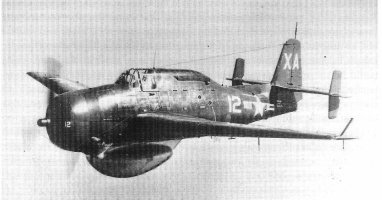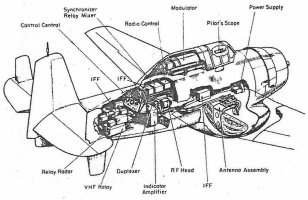![]() The Pacific War Online Encyclopedia
The Pacific War Online Encyclopedia
|
| Previous: Cadia | Table of Contents | Next: Cagayan Del Oro |
 NARA. Via Stern (2010) |
 NARA. Via Stern (2010) |
| Wavelength |
10 cm |
| Pulse Width | 2 microsecond |
| Power | 1 MW |
| Range | 200 miles or 320 km (surface ship) 60 to 120 miles or 90 to 190 km (6 to 14 aircraft flying at an altitude of 500 feet or 150 m) 45 to 70 miles or 70 to 110 km (single torpedo bomber flying at 500 feet or 150 m) |
| Scope |
Multiple PPIs in a surface ship
equipped to receive the data |
| Weight |
2300 lbs 1040 kg |
When Japanese kamikaze
aircraft made their
approach at low altitude, picket destroyer
radar often did not pick them up in time to give adequate warning. U.S. scientists responded by
developing an airborne early warning radar system, Cadillac, that was
based on an AN/APC-20 radar installed in a TBF Avenger.
Cadillac included
Identification Friend or Foe (IFF) and antijamming features and
transmitted its data directly to the Combat Information Center (CIC) of
a surface ship. The image was automatically rotated to account for the
heading of the aircraft. The relay link, AN/ART-22, was reliable at up
to 45
miles (72 km) distance.
The radar antenna was housed in a bulbous radome eight feet (2.4 m)
in diameter mounted between the landing gear. The aircraft was stripped
of its bomb bay, armament, and armor, both to make room for the
equipment and to allow the aircraft to reach an optimum altitude of
20,000 feet (6000 m). Two additional stabilizers were added to
the tail and a high-power line run from the engine to the set. Nine
other small antenna were located at various points on the aircraft. The aircraft crew consisted of a pilot and a radar officer in the control center in the rear fuselage of the aircraft.
The relay transmitter could select any of several channels around
300 MHz and had antijamming features. It was two-way, allowing the
surface ship to control the operation of the airborne radar.
The prototype XTBM-3W first flew on 5 August 1944, and 27 production
aircraft were ordered almost at once. The first production aircraft
came off the assembly line in March 1945, but the system was still in
the field testing stage at the time of the surrender. Cadillac would likely have
made a crucial contribution to fleet defense had the invasion of Japan actually taken
place, with each of three selected carriers participating in the invasion slated to receive four aircraft apiece.
References
The Pacific War Online Encyclopedia © 2009, 2013 by Kent G. Budge. Index